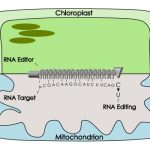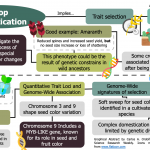Plant Science Research Weekly: July 31
Seed Evolution Special Issue
This week “Plant Science Research Weekly,” focuses on the evolution of seeds and includes a selection of recent papers that use varying approaches to increase our understanding of the origin and changes of different seed features. Since seeds are transversal to multiple aspects of plant life, this Special Issue aims to take the reader on a journey not only across different biological levels but also through time and space. As a result, while reading this edition, you will travel from the amaranth crops in South and Central America to the Tibetan Plateau, revisit the evolution of ovule and mucilage development, and take a trip in a floating coconut to explore how our knowledge of seeds history can inform the future of plants under ongoing climate change.
 Guest Editor: Carlos A. Ordóñez-Parra
Guest Editor: Carlos A. Ordóñez-Parra
Carlos is a Colombian MSc Student at the Universidade Federal of Minas Gerais (Belo Horizonte, Brazil), and part of the Plantae Fellows Class of 2020. His research focuses on seed ecophysiology and functional ecology. His current work looks to assess the functional traits that define the germination strategies found in Brazilian outcrop vegetation. Besides academia, he’s passionate about literature, photography, and archery. Twitter: @caordonezparra
Parallel Seed Color Adaptation during Multiple Domestication Attempts of an Ancient New World Grain ($) (Mol. Biol. Evol.)
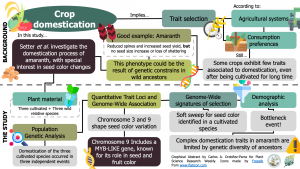 Amaranth has been cultivated in Central and South America since Pre-Columbian times. Still, it exhibits features that are unexpected in domesticated plants, such as seed shattering and reduced seed size. Here, Setter et al. dissected the genetic signature of this crop’s domestication process, with a particular interest in mapping the genes responsible for seed color changes from dark seeds in wild relatives to white ones in domesticated amaranths. Genetic differentiation was higher between cultivated amaranths than between cultivated and wild relatives, suggesting each crop species was domesticated independently. Quantitative Trait Locus (QTL) and Genomic-Wide Association (GWA) analysis showed that seed color changes are controlled by loci located in chromosomes 3 and 9. Interestingly, the chromosome 9 locus includes an MYB-Like transcription factor, known for controlling pigmentation in plant structures. Given this simple genetic structure, the authors discuss that white seed color could be easily fixed in each independent domestication process. However, this might not be the case for traits with a more complex genetic regulation. In fact, the authors’ demographic analysis provides evidence of a bottleneck event that could have reduced the genetic diversity of ancestor plants and limit the genetic variability available to human selection. (Summary by Carlos A. Ordóñez-Parra @caordonezparra) Mol. Biol. Evol. 10.1093/molbev/msz304
Amaranth has been cultivated in Central and South America since Pre-Columbian times. Still, it exhibits features that are unexpected in domesticated plants, such as seed shattering and reduced seed size. Here, Setter et al. dissected the genetic signature of this crop’s domestication process, with a particular interest in mapping the genes responsible for seed color changes from dark seeds in wild relatives to white ones in domesticated amaranths. Genetic differentiation was higher between cultivated amaranths than between cultivated and wild relatives, suggesting each crop species was domesticated independently. Quantitative Trait Locus (QTL) and Genomic-Wide Association (GWA) analysis showed that seed color changes are controlled by loci located in chromosomes 3 and 9. Interestingly, the chromosome 9 locus includes an MYB-Like transcription factor, known for controlling pigmentation in plant structures. Given this simple genetic structure, the authors discuss that white seed color could be easily fixed in each independent domestication process. However, this might not be the case for traits with a more complex genetic regulation. In fact, the authors’ demographic analysis provides evidence of a bottleneck event that could have reduced the genetic diversity of ancestor plants and limit the genetic variability available to human selection. (Summary by Carlos A. Ordóñez-Parra @caordonezparra) Mol. Biol. Evol. 10.1093/molbev/msz304
Phylogenetic analyses of key developmental genes provide insight into the complex evolution of seeds ($) (Mol. Phylogenet. Evol.)
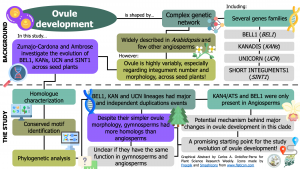 The complex genetic network behind the development of the ovule –the cell that will give place to seeds after fertilization– has been widely described in some model plants. However, ovules hold a high variability in integument number and morphology across seed plants. To understand the genetic mechanism behind this diversity, Zumajo-Cardona and Ambrose analyze the evolution of gene families known for its role in ovule development: BELL1 (BEL1), KANADIs (KAN1, KAN2, and KAN4/ATS), UNICORN (UCN) and SHORT INTEGUMENTS1 (SIN1). To achieve this, the authors look for homologs of these genes and map their changes and position in plant phylogeny. Three of these lineages (BEL1, KAN, and UCN) experienced several large and independent duplication events across seed plant evolution. Some homologs such as ATS and BEL1 were specific to angiosperms, suggesting they could be responsible for the major changes in ovule development in this clade. Interestingly, despite its simple ovule morphology, gymnosperms presented more gene homologs. However, whether these have the same functions as their angiosperms counterparts remains unclear. As a result, this exciting research is a starting point for future efforts about the molecular genetics of ovule development. (Summary by Carlos A. Ordóñez-Parra @caordonezparra) Mol. Phylogenet. Evol. 10.1016/j.ympev.2020.106778
The complex genetic network behind the development of the ovule –the cell that will give place to seeds after fertilization– has been widely described in some model plants. However, ovules hold a high variability in integument number and morphology across seed plants. To understand the genetic mechanism behind this diversity, Zumajo-Cardona and Ambrose analyze the evolution of gene families known for its role in ovule development: BELL1 (BEL1), KANADIs (KAN1, KAN2, and KAN4/ATS), UNICORN (UCN) and SHORT INTEGUMENTS1 (SIN1). To achieve this, the authors look for homologs of these genes and map their changes and position in plant phylogeny. Three of these lineages (BEL1, KAN, and UCN) experienced several large and independent duplication events across seed plant evolution. Some homologs such as ATS and BEL1 were specific to angiosperms, suggesting they could be responsible for the major changes in ovule development in this clade. Interestingly, despite its simple ovule morphology, gymnosperms presented more gene homologs. However, whether these have the same functions as their angiosperms counterparts remains unclear. As a result, this exciting research is a starting point for future efforts about the molecular genetics of ovule development. (Summary by Carlos A. Ordóñez-Parra @caordonezparra) Mol. Phylogenet. Evol. 10.1016/j.ympev.2020.106778
Review: Seed Mucilage Evolution: Diverse Molecular Mechanisms Generate Versatile Ecological Functions for Particular Environments ($) (Plant Cell Environ.)
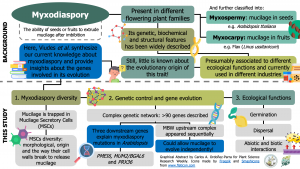 Plants with myxodiaspory release mucilage upon imbibition of seeds (myxospermy, e.g., Arabidopsis thaliana) or fruits (myxocarpy, e.g., Linum usitatissimum). This ability appears in several angiosperm families, but its evolutionary origin has seldom been studied. In this review, Viudes et al. synthesize our current knowledge about mucilage development in myxodiasporous species and provide insights regarding the evolution of the genetic machinery behind it and its ecological implications. Although similar at the macroscopic level, myxodiaspory is defined by a high diversity of microscopic traits that exhibit great variability, including Mucilage Secretory Cells (MSCs) origin and morphology, mucilage extrusion dynamic and mucilage biochemical composition. Moreover, myxodiaspory is a polygenic trait shaped by a complex genetic network of more than 90 genes. Surprisingly, all myxospermy-related mutations found in Arabidopsis natural populations have been associated with the pseudogenization of three downstream genes (PMEI6, MUM2/BGAL6, and PRX36), suggesting these genes are submitted to strong selection pressures and that myxospermy is a fast-evolving trait. Finally, the review concludes with insights about the impact of mucilage on germination, dispersal, and ecological interactions; the latter being an area that needs further exploration in future studies (Summary by Carlos A. Ordóñez-Parra @caordonezparra) Plant Cell Environ. 10.1111/pce.13827
Plants with myxodiaspory release mucilage upon imbibition of seeds (myxospermy, e.g., Arabidopsis thaliana) or fruits (myxocarpy, e.g., Linum usitatissimum). This ability appears in several angiosperm families, but its evolutionary origin has seldom been studied. In this review, Viudes et al. synthesize our current knowledge about mucilage development in myxodiasporous species and provide insights regarding the evolution of the genetic machinery behind it and its ecological implications. Although similar at the macroscopic level, myxodiaspory is defined by a high diversity of microscopic traits that exhibit great variability, including Mucilage Secretory Cells (MSCs) origin and morphology, mucilage extrusion dynamic and mucilage biochemical composition. Moreover, myxodiaspory is a polygenic trait shaped by a complex genetic network of more than 90 genes. Surprisingly, all myxospermy-related mutations found in Arabidopsis natural populations have been associated with the pseudogenization of three downstream genes (PMEI6, MUM2/BGAL6, and PRX36), suggesting these genes are submitted to strong selection pressures and that myxospermy is a fast-evolving trait. Finally, the review concludes with insights about the impact of mucilage on germination, dispersal, and ecological interactions; the latter being an area that needs further exploration in future studies (Summary by Carlos A. Ordóñez-Parra @caordonezparra) Plant Cell Environ. 10.1111/pce.13827
On the origin of giant seeds: the macroevolution of the double coconut (Lodoicea maldivica) and its relatives (Borasseae, Arecaceae) (New Phytol.)
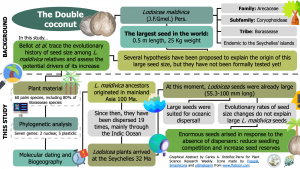 The double coconut –Lodoicea maldivica (J.F.Gmel.) Pers. (Arecaceae: Coryophoideae)– is an endemic palm from Seychelles with the largest seed in the world: 0.5 m length and 25 Kg weight. Several hypotheses have been proposed to explain the origin of this enormous seed, but they have not been formally tested. Here, Bellot et al. trace the evolution of seed size in among the Coryophoideae, focusing on the L. maldivica’s tribe (Borasseae). The authors built a dated phylogeny for this group and modeled its ancestral seed traits and dispersal history. L. maldivica ancestors appeared in mainland Asia 110 Ma. Since then, 19 dispersal events have occurred, mostly across the ocean. When ancestral Lodoicea plants arrived at the Seychelles 23 Ma, they already had 55.3-100 mm long seeds, meaning large sizes are capable of oceanic dispersal. Interestingly, the evolutionary rates for changes in seed size found by the authors are not enough to explain the impressive seed size of L. maldivica. Instead, the absence of a disperser able to transport these seeds probably led Lodoicea plants to invest in larger seeds to reduce sibling competition and provide the seeding with more reserves to establish in the shady environments they inhabit. (Summary by Carlos A. Ordóñez-Parra @caordonezparra) New Phytol. 10.1111/nph.16750
The double coconut –Lodoicea maldivica (J.F.Gmel.) Pers. (Arecaceae: Coryophoideae)– is an endemic palm from Seychelles with the largest seed in the world: 0.5 m length and 25 Kg weight. Several hypotheses have been proposed to explain the origin of this enormous seed, but they have not been formally tested. Here, Bellot et al. trace the evolution of seed size in among the Coryophoideae, focusing on the L. maldivica’s tribe (Borasseae). The authors built a dated phylogeny for this group and modeled its ancestral seed traits and dispersal history. L. maldivica ancestors appeared in mainland Asia 110 Ma. Since then, 19 dispersal events have occurred, mostly across the ocean. When ancestral Lodoicea plants arrived at the Seychelles 23 Ma, they already had 55.3-100 mm long seeds, meaning large sizes are capable of oceanic dispersal. Interestingly, the evolutionary rates for changes in seed size found by the authors are not enough to explain the impressive seed size of L. maldivica. Instead, the absence of a disperser able to transport these seeds probably led Lodoicea plants to invest in larger seeds to reduce sibling competition and provide the seeding with more reserves to establish in the shady environments they inhabit. (Summary by Carlos A. Ordóñez-Parra @caordonezparra) New Phytol. 10.1111/nph.16750
Cones structure and seed traits of four species of large‐seeded pines: Adaptation to animal‐mediated dispersal (Ecol. Evol.)
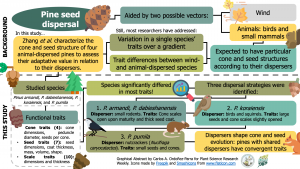 Different studies show that animal-dispersed pines have particular cone and seed structures to match their dispersers. However, most research has either addressed the changes in cone and seed traits in a single species over an environmental gradient or the differences between wind-dispersed and animal-dispersed pines. In this study, Zhang et al. characterize the cone and seed structure of four animal-dispersed pine species –Pinus armandi, P. dabieshanensis, P. koraiensis, and P. pumila– to assess the adaptive value of this morphology in relation to their disperses. The four species exhibited significant differences in mostly all features. Still, cone and seed traits allowed to separate the species into three dispersal strategies that coincide with their dispersers: (i) P. armandi and P. dabieshanensis, dispersed by small rodents, had cones with scales that open upon maturity and thick seed coats; (ii) P. koraiensis, dispersed by birds and squirrels, had large seeds and slightly open cones; and (iii) P. pumila, which had the smallest cones and seeds, is dispersed by nutcrackers (Nucifraga caryocatactes). Given this result, the authors emphasize the role of dispersers in shaping cone and seed evolution in pines, suggesting dispersers can allow different species to converge in similar cone and seed traits. (Summary by Carlos A. Ordóñez-Parra @caordonezparra) Ecol. Evol. 10.1002/ece3.6273.
Different studies show that animal-dispersed pines have particular cone and seed structures to match their dispersers. However, most research has either addressed the changes in cone and seed traits in a single species over an environmental gradient or the differences between wind-dispersed and animal-dispersed pines. In this study, Zhang et al. characterize the cone and seed structure of four animal-dispersed pine species –Pinus armandi, P. dabieshanensis, P. koraiensis, and P. pumila– to assess the adaptive value of this morphology in relation to their disperses. The four species exhibited significant differences in mostly all features. Still, cone and seed traits allowed to separate the species into three dispersal strategies that coincide with their dispersers: (i) P. armandi and P. dabieshanensis, dispersed by small rodents, had cones with scales that open upon maturity and thick seed coats; (ii) P. koraiensis, dispersed by birds and squirrels, had large seeds and slightly open cones; and (iii) P. pumila, which had the smallest cones and seeds, is dispersed by nutcrackers (Nucifraga caryocatactes). Given this result, the authors emphasize the role of dispersers in shaping cone and seed evolution in pines, suggesting dispersers can allow different species to converge in similar cone and seed traits. (Summary by Carlos A. Ordóñez-Parra @caordonezparra) Ecol. Evol. 10.1002/ece3.6273.
Phylogenetic relatedness mediates persistence and density of soil seed banks ($) (J. Ecol.)
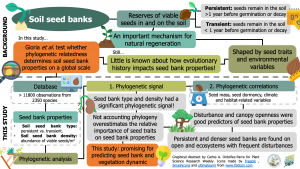 Soil seed banks are classified into two types, depending on how long seeds remain viable in the soil before germination or decay: transient (< 1 year) or persistent (> 1 year). In turn, a species’ ability to form a persistent seed bank presumably depends on seed traits and plant habitat. However, the impact of evolutionary history on seed bank properties has seldom been studied. Here, Gioria et al. build a dataset of 2350 species and test whether seed bank type and the seed density in the soil are shaped by phylogenetic relatedness on a global scale. Also, seed bank properties were correlated with different seed traits and habitat-related variables to assess the relative importance of phylogeny compared to these features. Seed bank type and seed bank density showed a significant phylogenetic signal, meaning that closely-related species tend to share similar seed bank properties. Still, seed mass, seed dormancy, and climate were poor predictors of seed bank properties. Instead, plants that inhabited open and disturbance-prone ecosystems consistently had denser and persistent seed banks. As a result, this fascinating study provides exciting insights into the role of phylogeny on seed bank formation on a global scale and its implications for vegetation dynamics. (Summary by Carlos A. Ordóñez-Parra @caordonezparra) J. Ecol. 10.1111/1365-2745.13437
Soil seed banks are classified into two types, depending on how long seeds remain viable in the soil before germination or decay: transient (< 1 year) or persistent (> 1 year). In turn, a species’ ability to form a persistent seed bank presumably depends on seed traits and plant habitat. However, the impact of evolutionary history on seed bank properties has seldom been studied. Here, Gioria et al. build a dataset of 2350 species and test whether seed bank type and the seed density in the soil are shaped by phylogenetic relatedness on a global scale. Also, seed bank properties were correlated with different seed traits and habitat-related variables to assess the relative importance of phylogeny compared to these features. Seed bank type and seed bank density showed a significant phylogenetic signal, meaning that closely-related species tend to share similar seed bank properties. Still, seed mass, seed dormancy, and climate were poor predictors of seed bank properties. Instead, plants that inhabited open and disturbance-prone ecosystems consistently had denser and persistent seed banks. As a result, this fascinating study provides exciting insights into the role of phylogeny on seed bank formation on a global scale and its implications for vegetation dynamics. (Summary by Carlos A. Ordóñez-Parra @caordonezparra) J. Ecol. 10.1111/1365-2745.13437
Among-population variation in seed mass for 190 Tibetan plant species: Phylogenetic pattern and ecological correlates (Glob. Ecol. Conserv.)
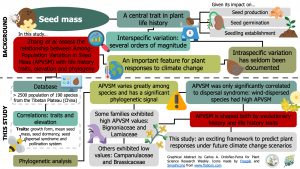 Seed mass is a central trait in plants life history that impacts on seed production, germination and establishment. Several studies have documented the variation in seed mass between species, but little is known about its variation among populations of the same species. In this paper, Zhang et al. assess the relationship between Among-Population Variation in Seed Mass (APVSM) with plant life history traits, elevation and species phylogeny. A dataset of 2503 populations from 190 species of the Tibetan Plateau (China) was built and the APVSM was estimated using the coefficient of variation of each species’ seed mass. APVSM varied significantly among species and had a significant phylogenetic signal, meaning that APVSM is conserved among related taxa. For example, families like Bignoniaceae and Lamiaceae species exhibited high APVSM, while Brassicaceae and Campanulaceae presented low ones. Interestingly, APVSM was only correlated to seed dispersal syndrome, with wind-dispersal species exhibiting higher values than other dispersal modes. Consequently, and given the impact of seed mass variability on plant establishment under changing environments, this study provides an exciting framework to predict plant responses under future climate change scenarios. (Summary by Carlos A. Ordóñez-Parra @caordonezparra) Glob. Ecol. Conserv. 10.1016/j.gecco.2020.e01163
Seed mass is a central trait in plants life history that impacts on seed production, germination and establishment. Several studies have documented the variation in seed mass between species, but little is known about its variation among populations of the same species. In this paper, Zhang et al. assess the relationship between Among-Population Variation in Seed Mass (APVSM) with plant life history traits, elevation and species phylogeny. A dataset of 2503 populations from 190 species of the Tibetan Plateau (China) was built and the APVSM was estimated using the coefficient of variation of each species’ seed mass. APVSM varied significantly among species and had a significant phylogenetic signal, meaning that APVSM is conserved among related taxa. For example, families like Bignoniaceae and Lamiaceae species exhibited high APVSM, while Brassicaceae and Campanulaceae presented low ones. Interestingly, APVSM was only correlated to seed dispersal syndrome, with wind-dispersal species exhibiting higher values than other dispersal modes. Consequently, and given the impact of seed mass variability on plant establishment under changing environments, this study provides an exciting framework to predict plant responses under future climate change scenarios. (Summary by Carlos A. Ordóñez-Parra @caordonezparra) Glob. Ecol. Conserv. 10.1016/j.gecco.2020.e01163


